Indigenous and quilombola communities of Caucaia-CE host IBGE to talk about 2022 Census
March 18, 2022 11h15 | Last Updated: March 25, 2022 10h39
“Having the land demarcated, they tore my house down, they tore everything down. Everybody went to the middle of the street,” reminds Chief Alberto, leader of the Tapeba do Sobradinho village, who had already been expelled from his land to open a highway some years ago. “We now need a bridge, because we do not have one for our relatives,” completes him. In the community of Maria Érica Braga Silva, Boqueirãozinho Quilombo, the demand is for children: “we work hard to get an education of quality, a full-time daycare, recognized as quilombola.”
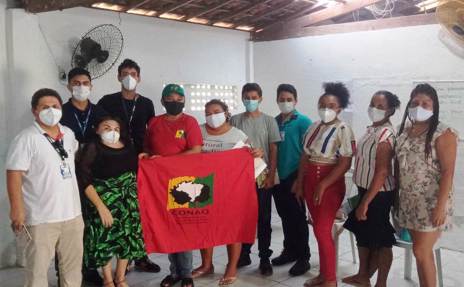
Repac with quilombola communities in Caucaia-CE
Basic demands like these, for housing, infrastructure and education, as well as some many others, is common for most Brazilians. For some communities, like those of indigenous and quilombola peoples, the difficulties are even greater when pleading public policies. “Because we feel it a lot, that our peoples, our history, our culture are invisible,” denounces Paulo França Anacé, leader of the Anacé indigenous people in Lagamar do Cauípe.
Chief Alberto, Maria Érica Silva and Paulo Anacé are leaders of traditional peoples and communities in Caucaia, Ceará. Their demands, doubts and specificities were listened by the IBGE in the 2022 Population Census Planning and Monitoring Meetings (Repacs), extraordinarily carried out with traditional peoples and communities. Although the 2022 Census does not directly foster the improvements demanded, it will produce, however, a whole set of data key to the development, requirement and implementation of public policies in the entire country, including in these communities.
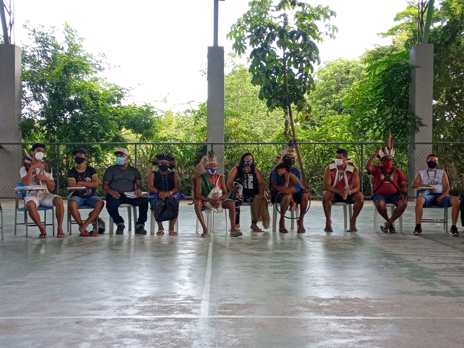
Repac with indigenous peoples in Caucaia-CE
“We want they as our full partners”
Following the health protocols against Covid-19, the IBGE team used masks and alcohol gel during the meetings, as well as previously tested in the case of contact with indigenous communities. The first meeting was carried out with leaders of indigenous peoples in the morning of February 23 at the Tapeba do Trilho Village Indigenous School. The second meeting was held one week later, in the afternoon of March 3, with representatives of quilombola communities gathered in Nedi Vó Sinhá daycare in the remnant community of Boqueirãozinho Quilombo.
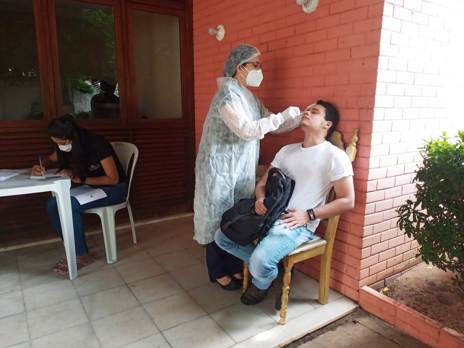
IBGE team tests for Covid-19 before contacting indigenous leaders
In the two meetings, the Census Area Coordinator in Caucaia, Luciano Vieira, approached several topics related to the work with traditional populations, like: census operation, questionnaire themes, exclusive questions for these communities, structure built for data collection, teams that will be working and development of the territorial base, as well as reinforced the need to reach all the communities. In the end of the meetings, the Census Sub-area Coordinator, Daniel Bezerra, collected the contacts of each one of the leaders present, in order to establish a more direct communication with these peoples. The meetings were also finished with the exhibition of geo-referenced maps by the IBGE, in which the indigenous and quilombola representatives could locate their land and communities.
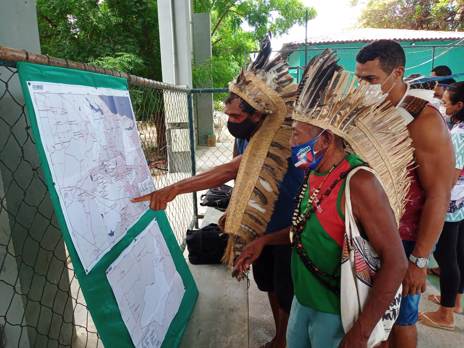
Chief Alberto (ahead) and other indigenous leaders in Caucaia-CE locate their villages in the maps geo-referenced by the IBGE
The aim of the meetings was to approach the traditional communities and peoples, encouraging them to participate actively and consciously in the data collection. Therefore, the 2022 Census can really portray how these communities live. “It is interesting to note that the indigenous and quilombolas are already convinced of the importance of the Census, and they strive to it. So we can establish the partnership,” celebrates the anthropologist and Census Analyst of Traditional Communities and Peoples, Fábio Jota, who helped to answer many questions raised in the meetings.
“We want them as partners in every sense,” highlights Luciano Vieira, who took advantage of the meetings to request the cooperation of the leaders, by providing information for a suitable approach, enabling a support structure and local guides to host the teams and pointing out groups that could be possibly unmapped, as well as reinforcing the importance of answering correctly the questionnaire in their communities.
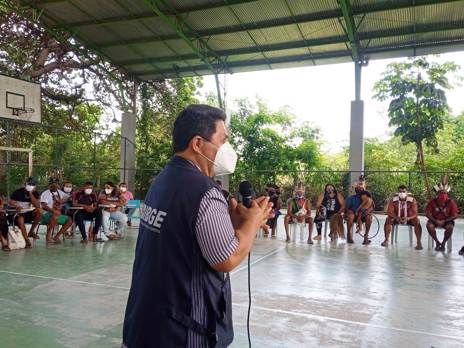
Area Coordinator Luciano Vieira conducting the Repac with indigenous leaders
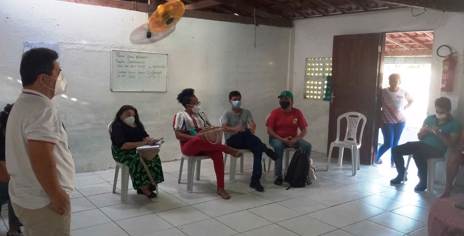
Area Coordinator Luciano Vieira conducting the Repac with quilombola leaders
“The Census multiplies and promotes our communities”
The 2022 Population Census is innovative in terms of detailing the mapping of traditional communities and peoples. The reason is that the IBGE crossed data from a number of sources to develop its own territorial base, where indigenous and quilombola territories and groups are geo-referenced in the entire country. In these localities, specific questions will be automatically opened in the questionnaires, investigating other aspects about the reality of these peoples and communities, based on their self-declaration. In the case of indigenous people, the specific questions will also be triggered whenever someone self-declares as indigenous, regardless where they live. Beyond a more precise counting, these changes aim at obtaining subsidies for a more precise description of how these groups live.
This step of the 2022 Census is being positively assessed by the leaders in Caucaia. “The rapprochement that the IBGE coordinators are having with the traditional peoples is an advance,” highlights Isabel Cristina Silva de Sousa, known as Cristina Quilombola, one of the representatives of the National Coordination of Articulation of Quilombos (Conaq) in the state of Ceará and president of the quilombola community of Caetanos in Capuan. “The Census multiplies and promotes our communities,” stresses the quilombola leader, who sees the IBGE work as an opportunity to improve the mapping they have already done.
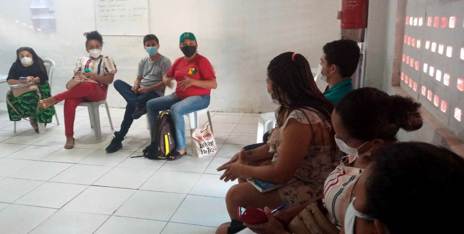
Cristina Quilombola (in red, center), of the Caetanos do Capuan community, approached the advance that the Census represents in the mapping of quilombola communities
“I believe that this specific form for native peoples in Brazil helps a lot to map our communities,” also notes Ricardo Weibe Nascimento Costa, known as Weibe Tapeba, an indigenous leader of the Lagoa dos Tapeba village, as well as a lawyer of the Indigenous Popular Advocacy Office, coordinator of the Federation of Indigenous Organizations and Peoples of Ceará (Fepoince) and also a city councilor in the municipality of Caucaia. “Our effort in 2022 is to guarantee the data more reliable as possible. Our country is a multiethnic and multilingual one, and these data should come out for us to plead a space in the national society,” completes him.
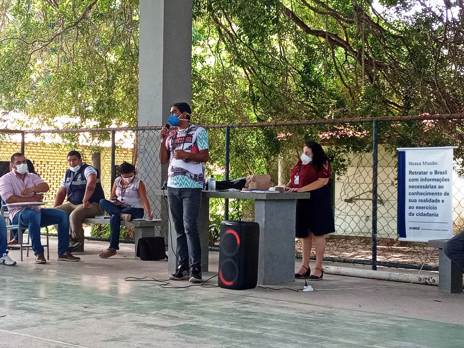
Weibe Tapeba (standing with the microphone), of the Lagoa dos Tapeba village, highlighted the importance of the Census data to plead public policies
“That public policies reach the floor of the villages”
The indigenous peoples of Caucaia who participated in the extraordinary Repac assessed that the information collected in this Census can contribute in many ways to strengthen their demands. For Paulo Anacé, the Census represents visibility: “We, the Anacés of Cauípe, live inside an industrial complex. To show that we live there is to show that all that progress is disrespecting our existence. [The Census] is good for them to see that this method of development is completely out of our preservation history.” For Chief Alberto, the Census can bring more security to his people: “I think it is important, because we have been discriminated in my entire life. Maybe we are respected in our indigenous reservations from now on. City councilor Weibe Tapeba also highlights that “the Census is the major planning tool to access public policies.” For him, “to qualify who are the indigenous peoples is key to the policies to reach the floor of the villages.”
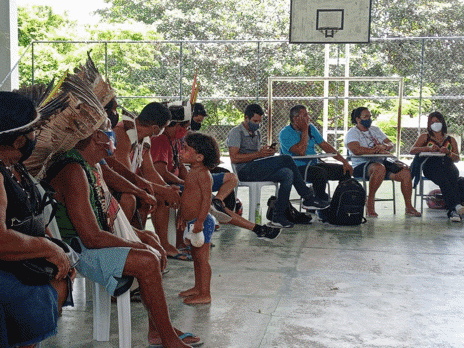
More records of the Repac with indigenous peoples in Caucaia-CE
In the meeting with the quilombola groups in the municipality, the leaders also pointed out that, once they access the Census data, they may use them for the development of their communities. Maria Érica Silva considers this an opportunity of knowledge: “The Census is very important, as it will map and study every region. It will help us a lot.” Cristina Quilombola, in turn, mentions a number of items in the agenda of the movement that can be stepped up after the 2022 Census: “strengthening of the quilombola territory, fight for education, recognition of Law 10,639 [that enforces the teaching of African-American culture and history in the primary and secondary schools], territoriality, environment, which we already work in our territories. The Census will strengthen even more the guarantee of our social rights and several other fights.”
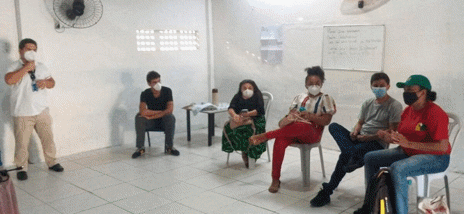
More records of the Repac with quilombola communities in Caucaia-CE
“The meetings are very positive,” assessed anthropologist Fábio Jota in the end of the meetings in Caucaia. “They show the willingness of the IBGE that this work be well done and get the best result as possible. They also show that there is a huge mobilization of the quilombola and indigenous leaders and organizations for the data collection to happen.” After this first successful round of Repacs with traditional communities and peoples, it is proposed to also carry out, in the next months, these meetings in other regions of Ceará with quilombola and indigenous communities and peoples, assuring that all of them will be reached by the 2022 Census.
